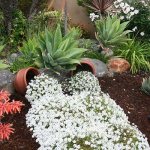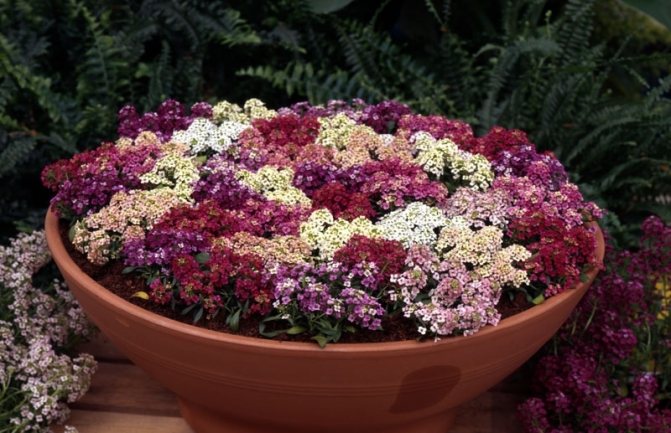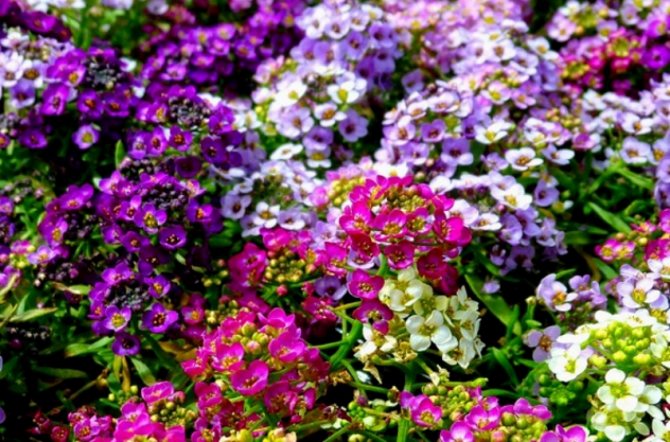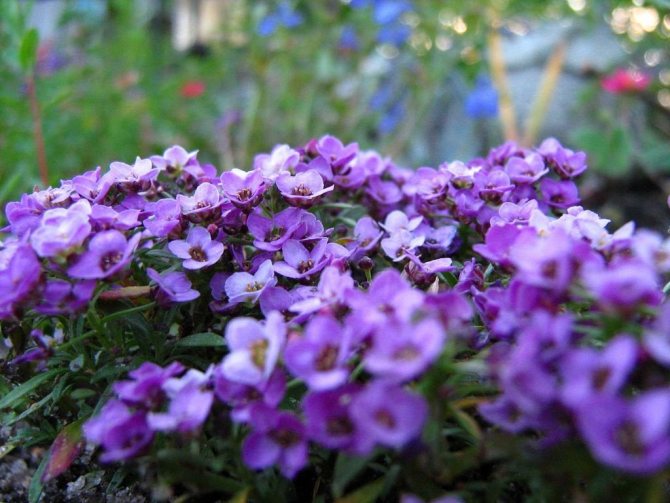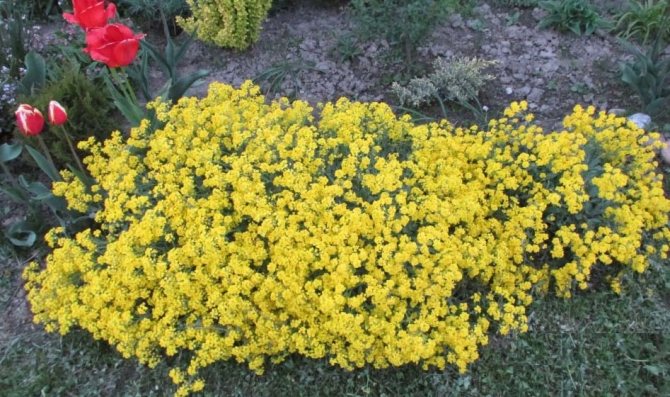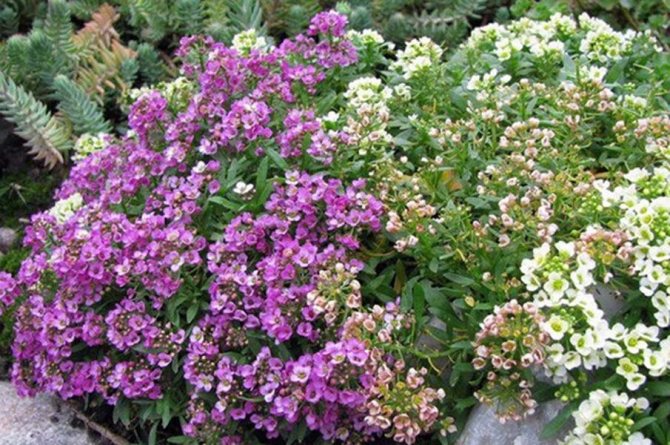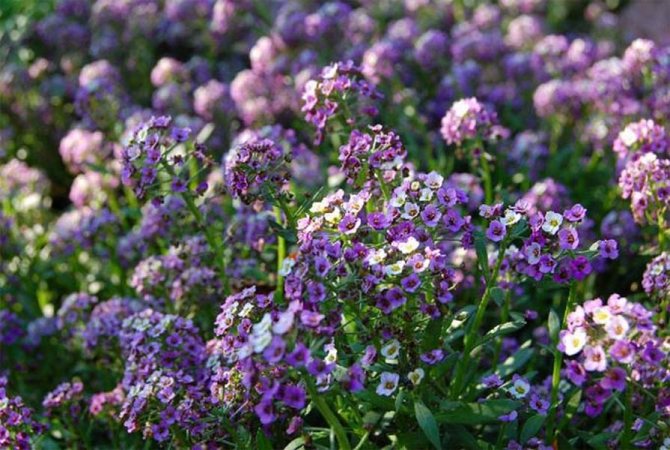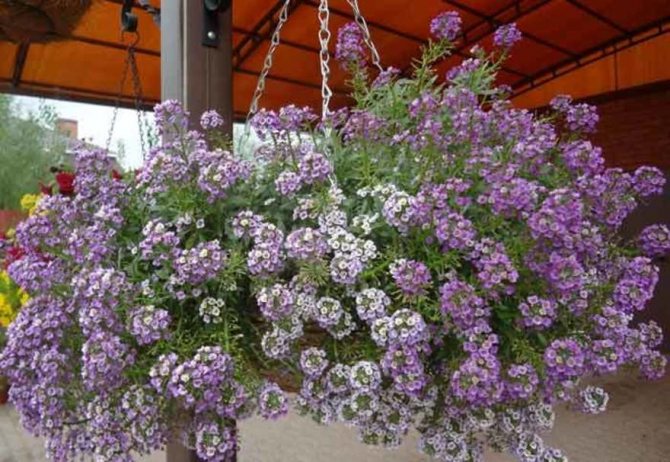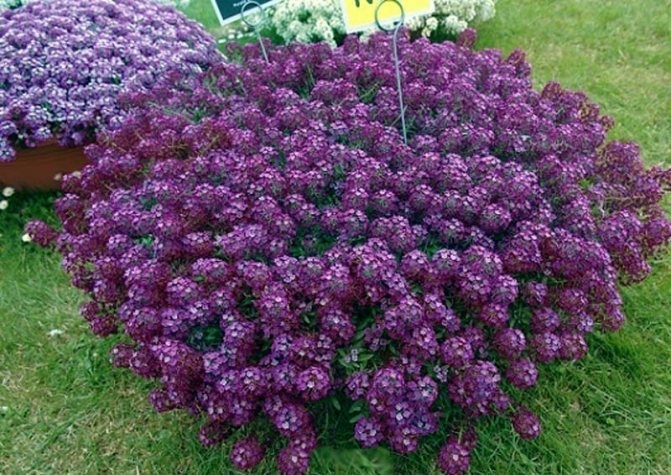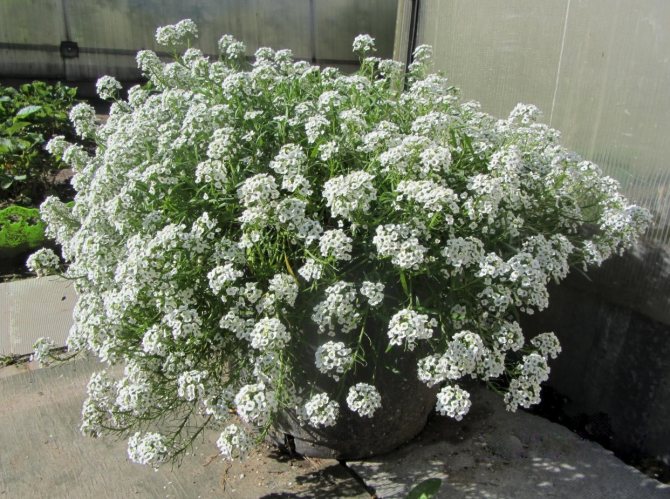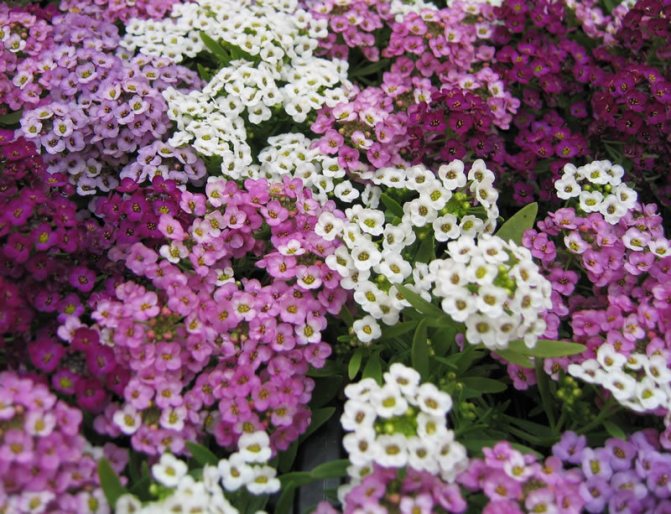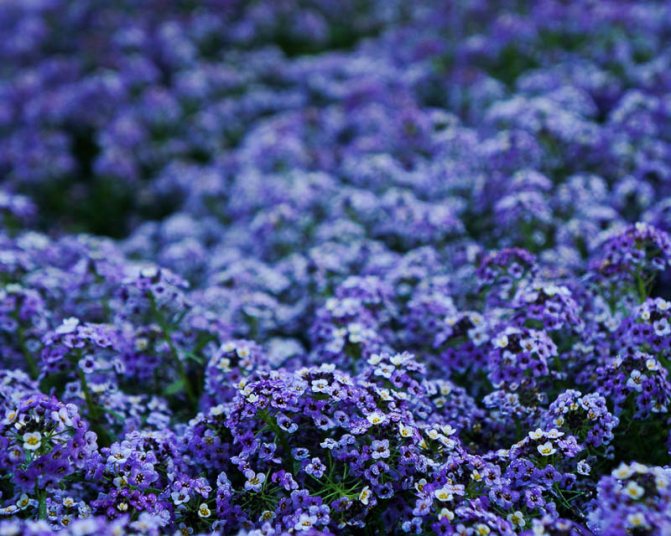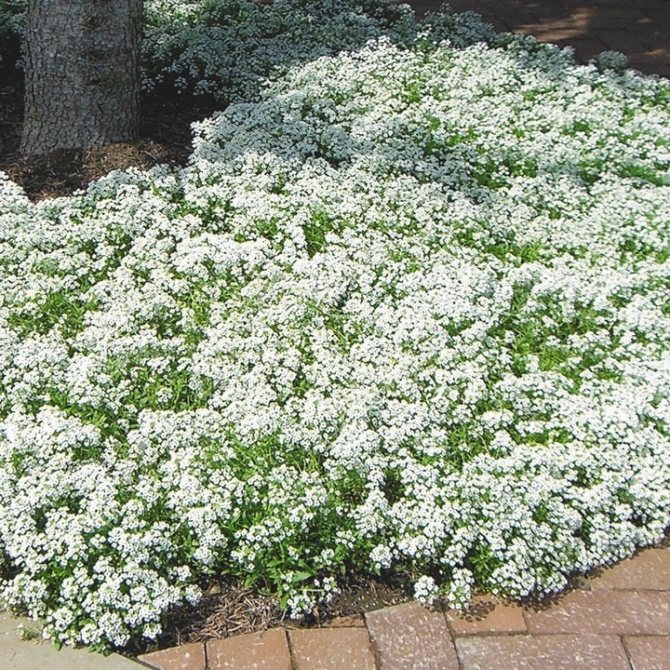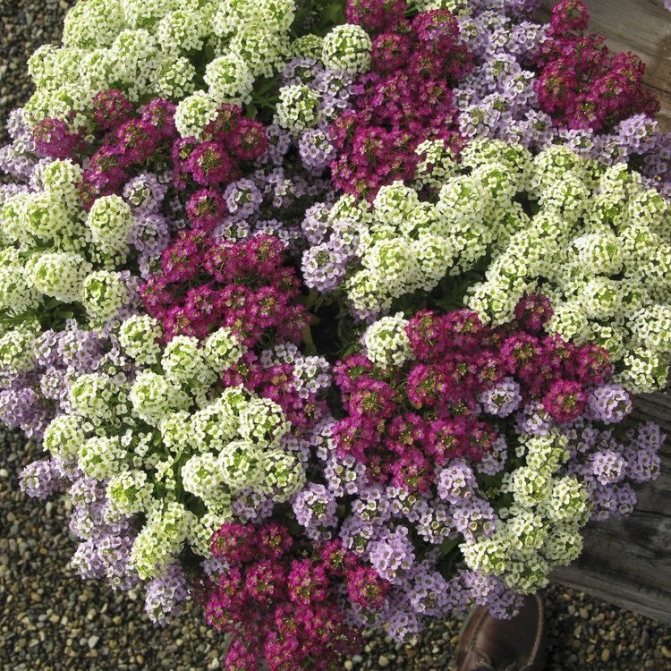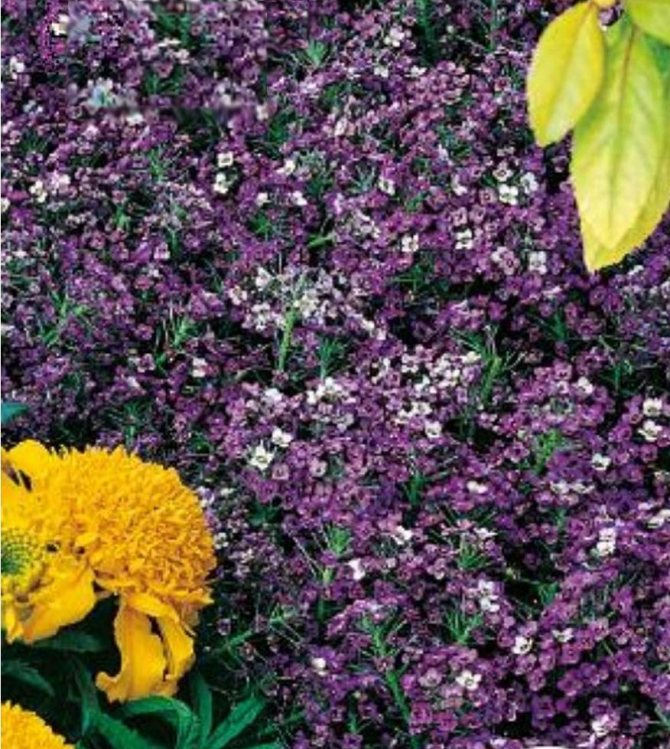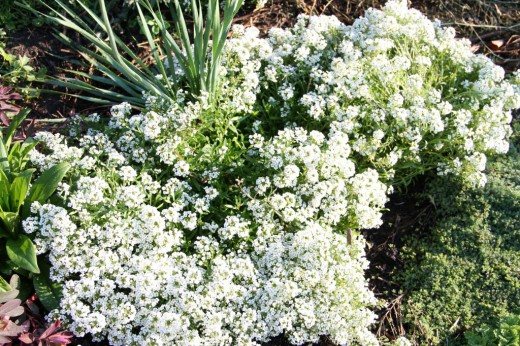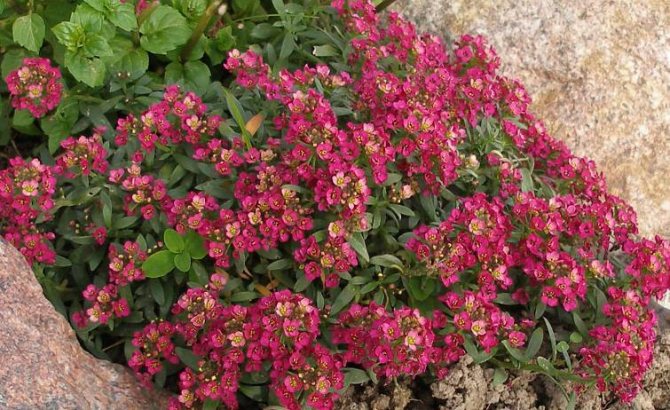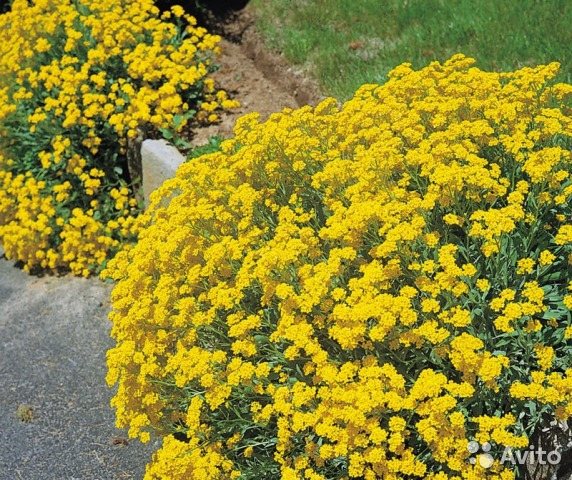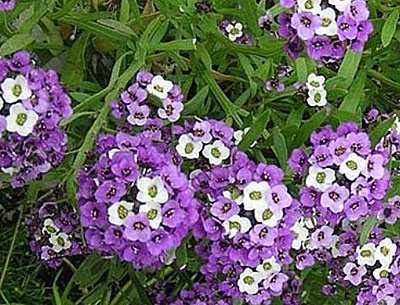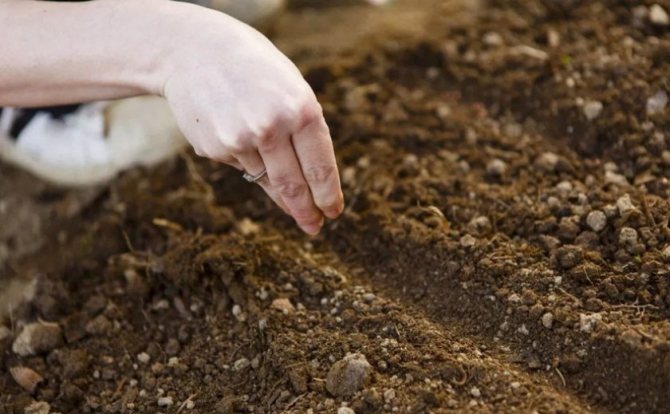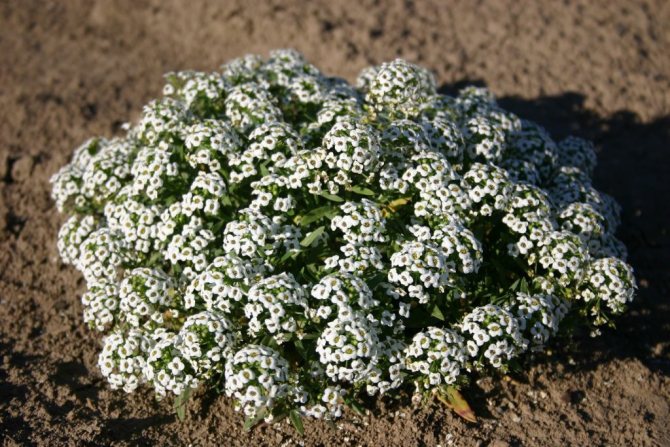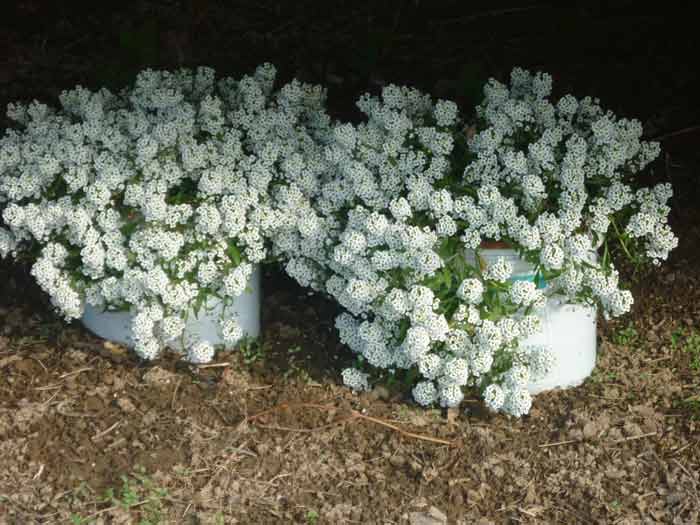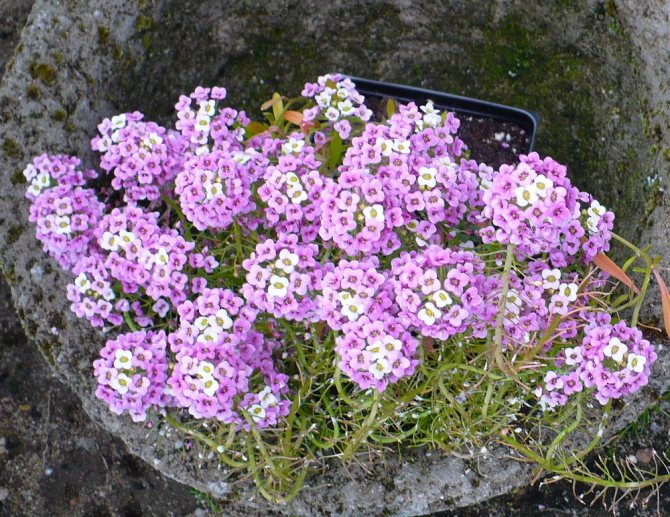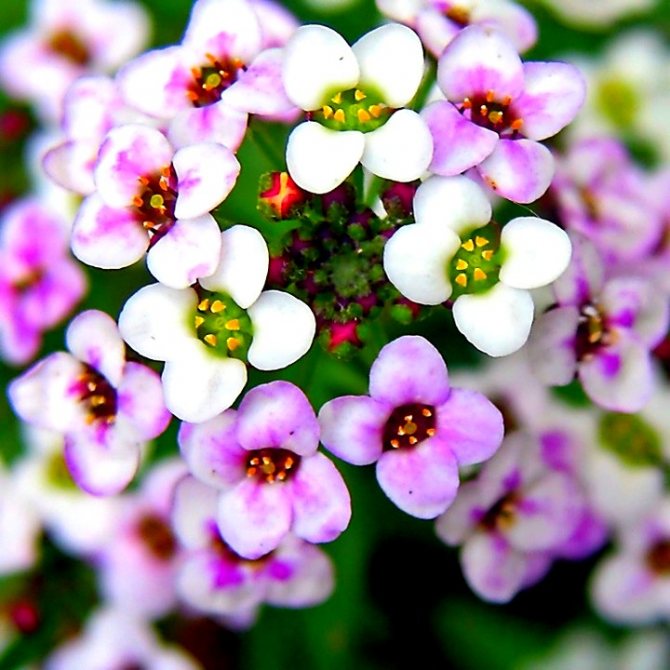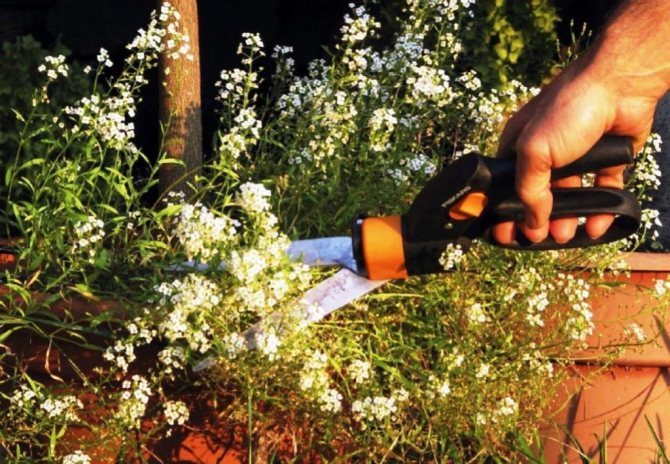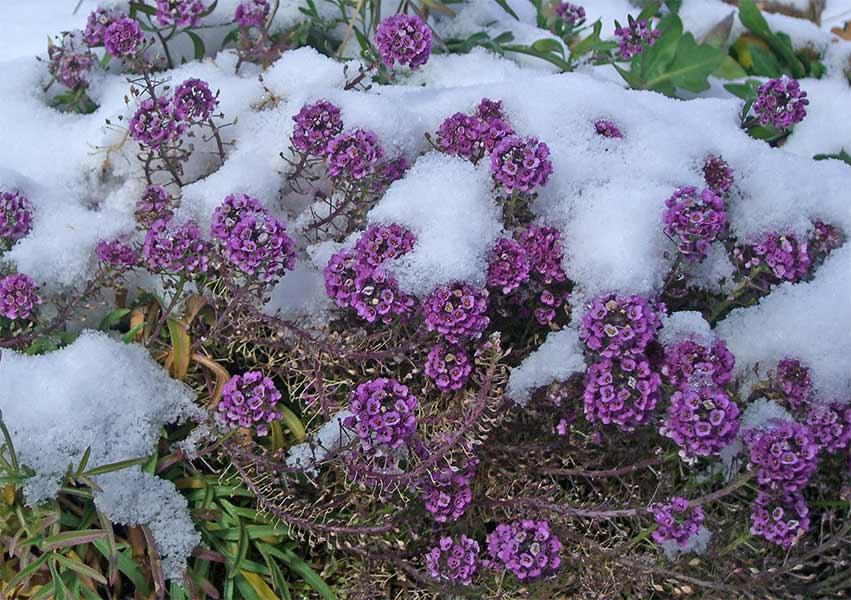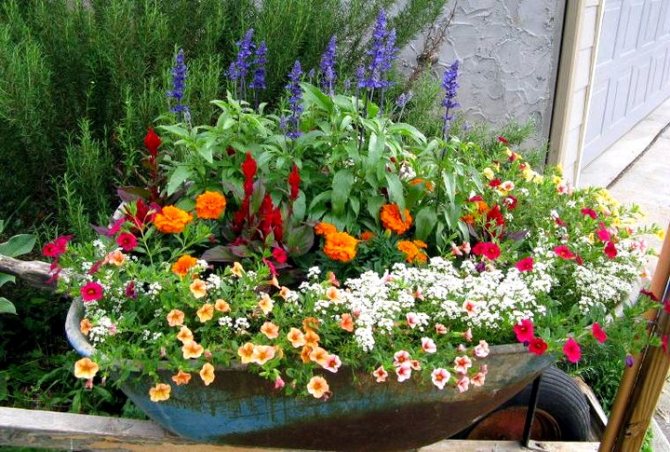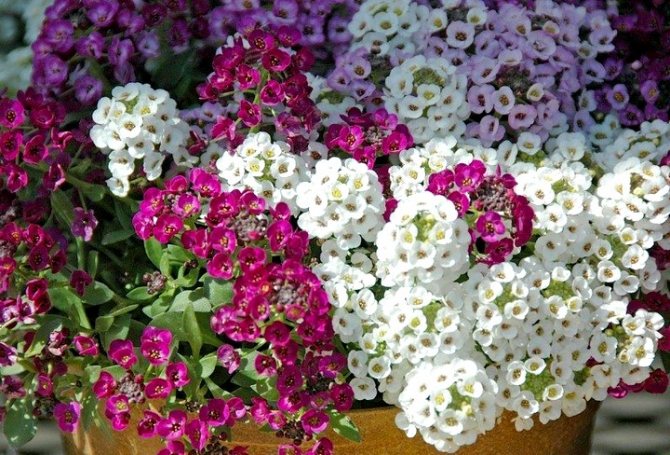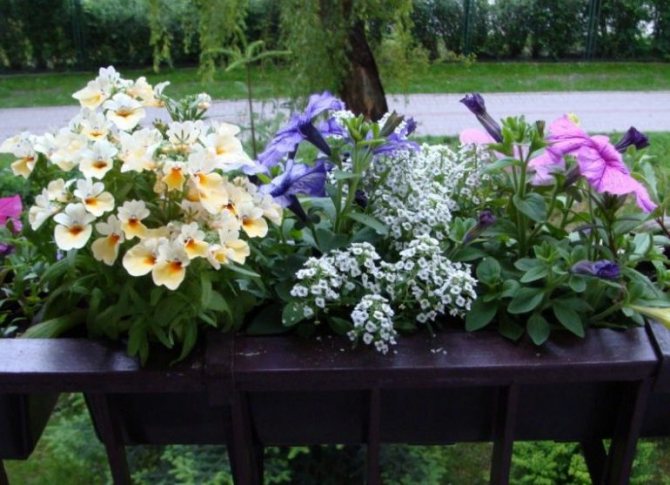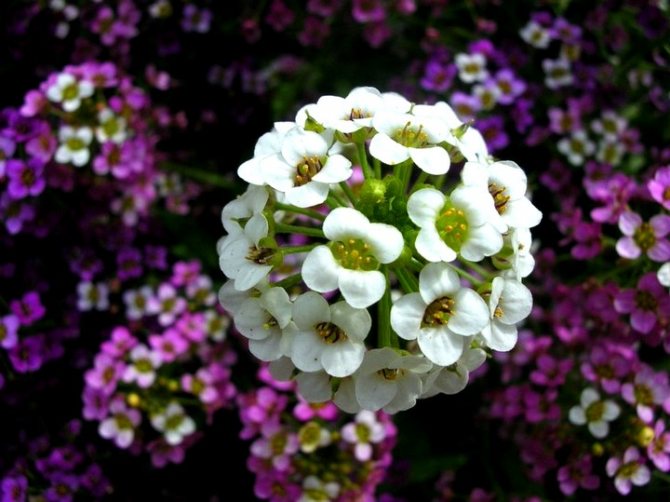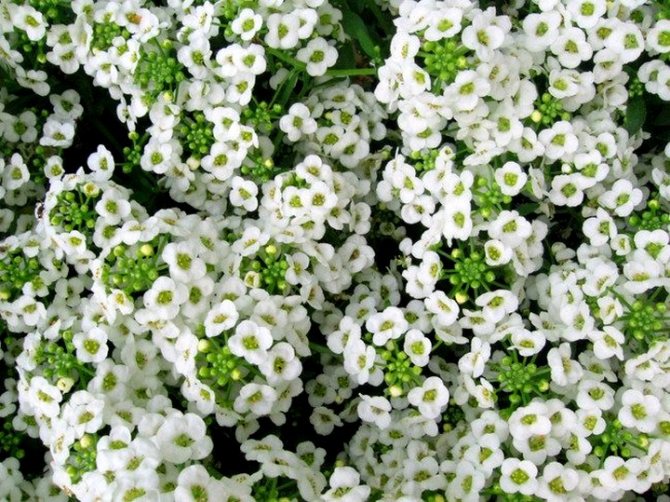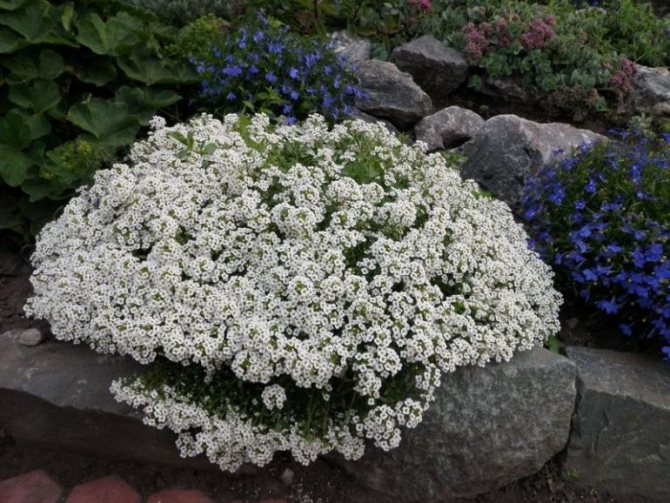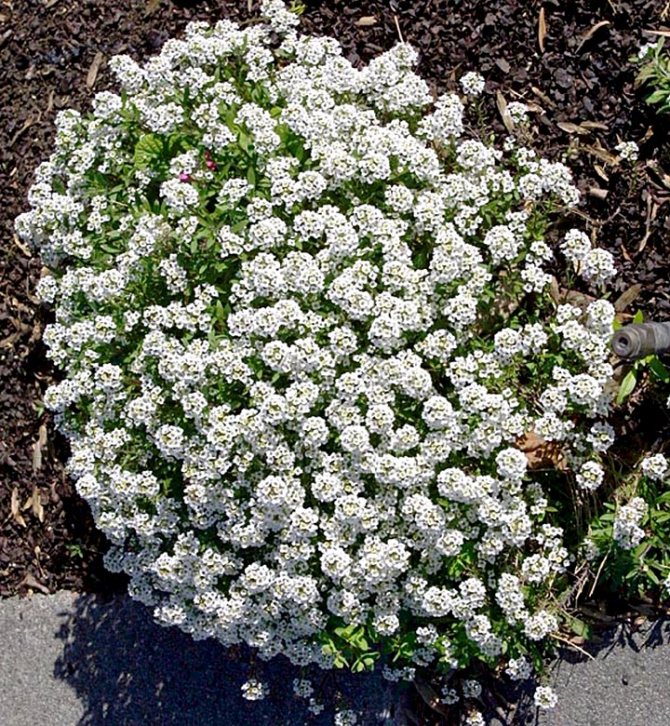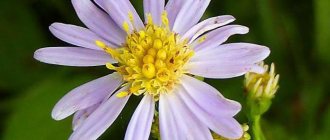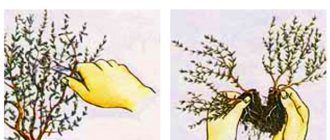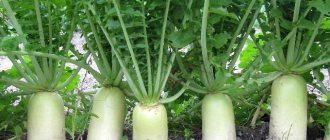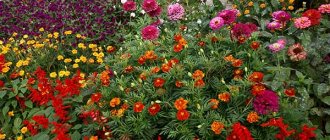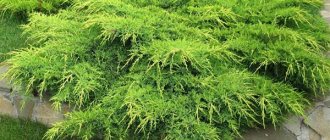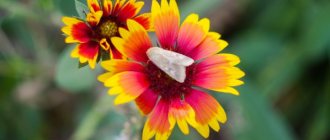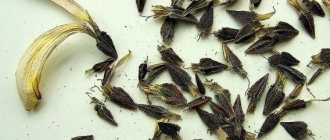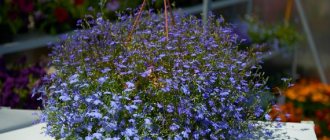Florists are very fond of alyssum not only for the beauty of the white clouds of its flowers, but also for its unique honey aroma. Yes, and it is difficult to relate differently to this short, compact ground cover plant with a dizzying, but not at all annoying smell, moreover, frankly loved by insects - pollinators. So an irresistible desire arises to grow a remarkably pleasant, and yet undemanding and grateful bush. You can read about how to plant alissum on seedlings and in open ground, about proper care and cultivation below.
By the way! Annual alissum is usually called lobularia, although, as a rule, these names are used interchangeably.
Alyssum flowers description
Alyssum is a dwarf plant, ground cover, reaching a height of 15 to 40 cm. On the strongly branching semi-lignified shoots at the base, small pubescent oblong or obovate leaves. The flowers are small, white, yellow, lilac, pink, red or purple, collected in small brushes, bloom in May and fade in late autumn. The fruit is a pod with seeds that remain viable for up to three years. Alyssum is a honey plant that attracts bees with its spicy honey aroma. Strictly speaking, sea lobularia and alyssum are not the same plant, but they are close relatives and are so similar that for simplicity, flower growers unite them into one genus. The difference is simply determined: in Alyssum, the flowers are pale yellow or yellow, and in the Lobularia, they are white, lilac or pink.
Variety selection
Currently, both the original, natural forms of alissum and new varieties carefully bred by breeders are cultivated. The rich list of varieties includes annual and perennial forms.
Table of the most common varieties
| Name | Description | Life cycle |
| Squat, up to 8cm high, sprawling bushes with green foliage, densely covered with really snow-white inflorescences. | Annual |
| It only grows up to 10 cm in height. Inflorescences are purple, pink, red. | Annual |
| Low, up to 20 cm, bushes with silvery-pubescent foliage bloom profusely with a bright yellow carpet in the second year after sowing. | Perennial |
| Height up to 15 cm, gray-green leaves, deep purple inflorescences, brightening in the center. | Annual |
| "Palette" | It grows no higher than 15 cm, forms a scattering of inflorescences, representing many delicate shades of cream, pink, yellowish, purple and brown. | Annual |
Types of alissum
Many species of perennial and annual plants are known. This garden culture surprises with an abundance of colors, so you can grow flowers of pink, red, white, purple and other shades.
- Alyssum annual
More often, gardeners use annual varieties, so you can regularly change landscape compositions. The original forms are the following varieties of alyssum: "Bentama", compact, variegated and prostrate. Breeders, by combining them, have obtained many hybrid forms that are easy to grow from seed. In the description of alyssum, it is indicated that annual crops should be sown in prepared light soil in mid-April.
- Alyssum perennial
Sowing alyssum for seedlings
Most flower lovers, of course, want to see earlier flowering and seedlings help out here. Alyssum seed growing when to plant? We begin to deal with seedlings in mid-March. We need a light nutrient soil, a slightly acidic medium (pH 5.5-6.2). However, it will grow in any, but we are talking about optimal conditions. We put the soil in the seedling box, spread the seeds over the surface and lightly sprinkle it with the same soil, or simply press it to the surface, moisten it with a spray gun.
We create conditions close to ideal:
- cover with glass or foil,
- temperature 10-15 degrees,
- moderate humidity.
In less than a week, friendly seedlings will appear, we remove the protective film or glass. After the appearance of the first true leaf, the time comes for the first feeding - a complex fertilizer will do. When two or three leaves appear and the seedlings get stronger, you can transplant. Gently dive the seedlings into the pots using a fork or toothpick.
From the beginning of May, the seedlings must be hardened by taking them outside for a few minutes every day. Alyssum can be planted in open ground at the end of May. The seedlings will begin to bloom in a month and a half.


Varietal variety
There are many varieties of Alyssium. But not all of them are suitable for decorating flower beds and borders.
The most popular are only about 6-8 varieties.
Rocky
The height of this perennial variety reaches 0.25 m. Differs in density and branching. When growing, forms a spherical compact form, dotted with small yellow flowers.
This variety has three subspecies - Golden Wave, Plenum, Compactum.
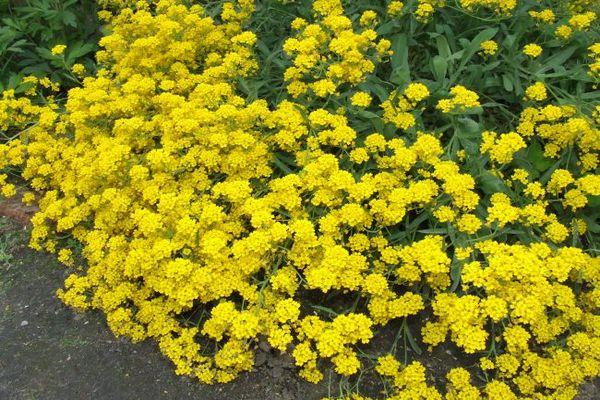

Gmelin
This is a stunted and frost-resistant Alyssium. The plant has a gray-green foliage and quite densely covers the soil due to spreading over the surface.
Flowers are yellow, form knocked-down inflorescences. They have an intense honey aroma.
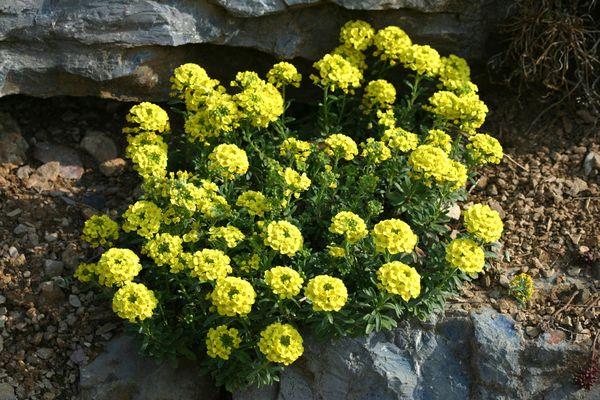

Nautical
A perennial bush of oval, compact, dense shape, thriving in temperate climates. The flowers are silvery. It blooms not only profusely, but also for a long time - it will delight its owners from mid-spring to early autumn.
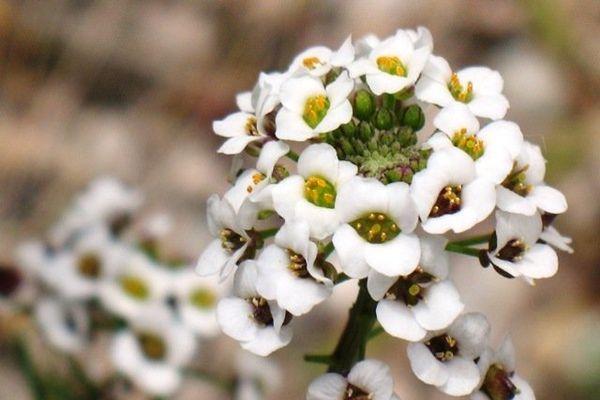

Ampelny
Growing Alyssum in hanging pots can be spectacular. For this, ampel varieties are used, such as Esther Banner, Pastel or White Wave.
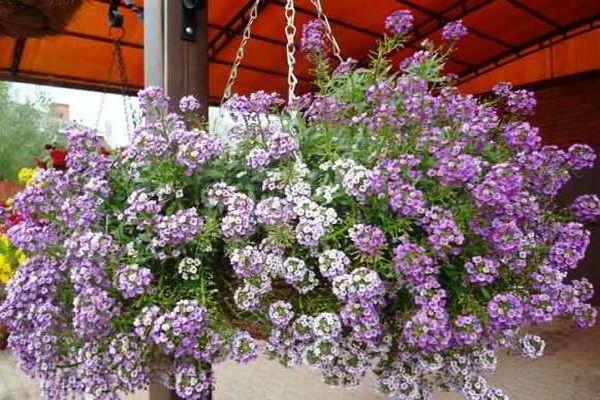

Snow carpet
It is a miniature, compact plant with white flowers with a honey aroma and intensively creeping along the ground. Blooms only in summer.
Sowing alyssum in open ground
If you are determined to sow seeds directly in open ground, you need to wait for really warm weather. Unlike greenhouse sowing, seeds can be planted in open ground no earlier than May. They are buried in the ground no more than 0.5 cm. If they are planted deeper, the sprouts will not have enough strength to break through the soil. Important! If the alissum in the garden plays the role of a living border, then the distance between the plants can be made as low as possible. When planting seeds, calculate the distance between flowers so that they do not interfere with each other - this is about 15 to 40 cm.
Plant propagation
You can get new specimens in 2 ways: by seed propagation or by cuttings.
- Reproduction of alissum seeds - The easiest way. You just need to embed the seeds in the soil to a depth of 1.5 cm and wait for the shoots. When the seedlings start to grow, the plantings need to be thinned out in order to provide the plants with sufficient nutrition and proper care in the future.
- Cuttings... Less common, but also a good way to expand your collection. Over time, the bushes grow and become spreading. The plant becomes unattractive and needs to be renewed. You can cut the cuttings and put them in water, plant them in a pot, or put a mound of soil on a lignified stem.In order for the lateral processes to root faster, the first time should be watered abundantly. Closer to autumn, the rooted bushes should be dug up and planted in a permanent place. The old plant should be thrown away without regret to make room for new plantings.
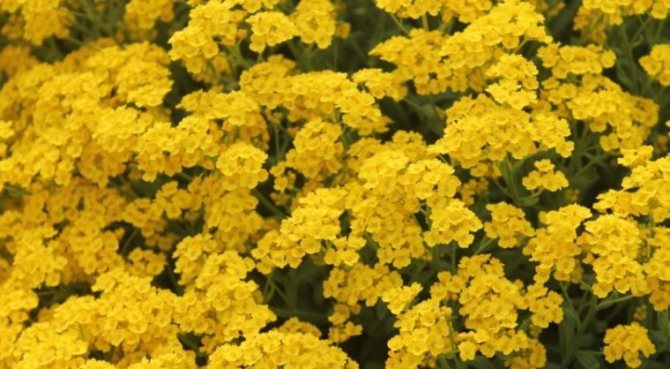

Watering alyssum
The Alyssum flower, the care of which is considered in the article, requires constant watering. The plant can rot due to severe waterlogging. Well-drained soil solves this problem. So, water will not stay in the root system. Abundant regular watering is the key to a beautiful long flowering. How do you determine the balance? The earth under the bush needs to be dug four to five centimeters. If it is dry, it should be watered. Do not be afraid if the plant is a little dry in hot weather. It recovers quickly enough.
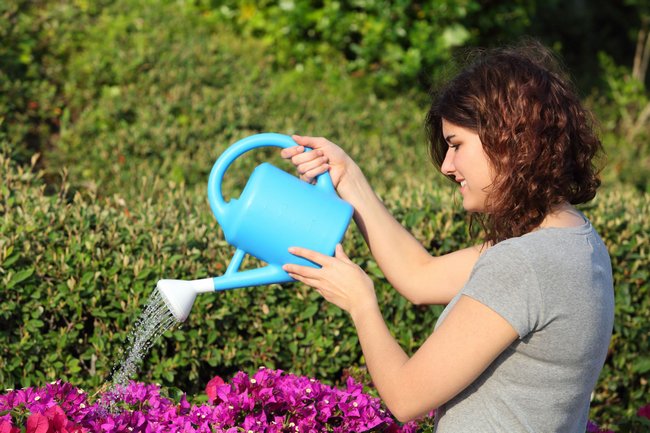

Healing properties
In folk medicine, the plant is prized for its medicinal properties. The infusion of the plant is used as a diuretic and laxative. It is useful to drink when bitten by a rabid dog.
If you wipe your face with infusion from the inflorescences of the plant, age spots and freckles will disappear.
During colds, a decoction from the plant helps relieve fever.
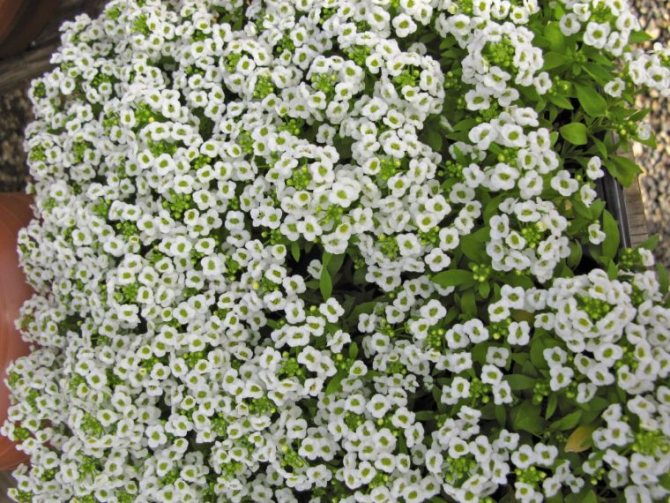

Feeding alyssum
Growing Alyssum flowers involves feeding. Perennial plants are fertilized into the soil before the flowering stage. Annual lobularia need to carry out several dressings per year. Then flowering will not stop. Some gardeners believe that a plant needs three feedings a year, regardless of its lifespan.
A ready-made solution is suitable as a fertilizer. Organics are not recommended to be used. The solution must be added to the root system. It is important not to spill it on flowers and leaves.
Additional tips and tricks
Care needs to be adjusted depending on whether annual or perennial Alissums are grown. So for perennials, pruning is required in the spring, when young shoots are intensively germinating, and in the fall, in order to remove dead wood.
Moreover, such a manipulation will allow you to form a bush of the desired shape and prolong the flowering process.
For all varieties, regardless of their growth period, top dressing must be applied 2 times during the growing season in one year. The first feeding is done in the spring, when the green mass begins to form intensively.
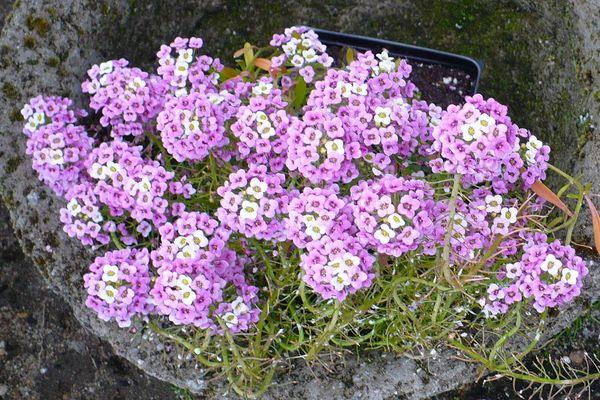

The second is carried out before flowering or in its middle, in order to maintain the vitality of the plant.
Planting alissum for the winter
Some gardeners practice sowing alyssum immediately after harvesting the seeds, in August-September. If the plant overwinters, then the seedlings will appear very early, they will bloom several weeks earlier than their counterparts sown in spring. But there is a high probability of freezing of all planting material due to its shallow location. Therefore, it is necessary to decide when to start growing alissum from seeds, taking into account the duration and temperature of the coming winter. As a last resort, you can always fill in the gaps with spring sowing.
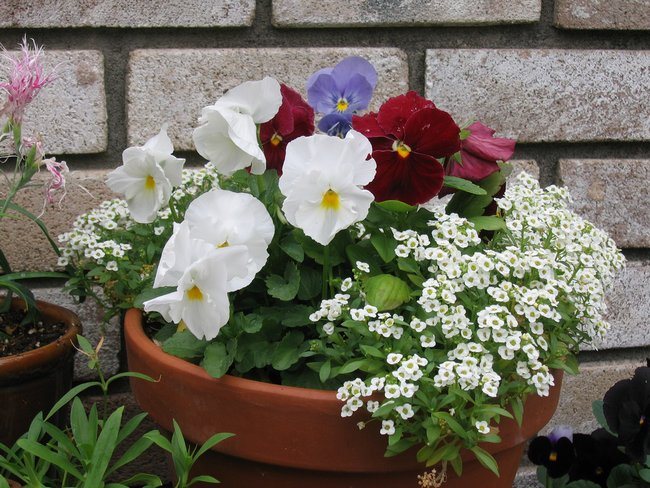

How to prolong flowering
In order to achieve the longest and most continuous flowering period, it is necessary to arrange pruning with the complete removal of elongated, dried inflorescences. All shoots are shortened by 5 cm. Seasonal autumn and spring pruning is also carried out, which help gardeners to obtain abundant color for a long time.
Alyssum after flowering: how and when to collect alyssum seeds
Lobularia begins to collect seed in the third decade of September and in early October. It is advisable to choose a calm, dry weather in order to ensure complete collection and not lose seeds. On the garden plot or on the territory of the courtyard, you need to spread a towel or bedspread, on which to manually rub the inflorescences.
Upon completion, large husks are removed, the seed is thoroughly dried in a well-ventilated room, after which it is placed in bags made of natural fabric and sent to storage in a dark and dry place. In the case when the gardener was late with the collection of seeds and they had time to crumble, it is necessary to carefully sweep the seed material out from under the branches and select the necessary specimens.
Alyssum pests
It should be remembered that the plant belongs to the same species as the cabbage, therefore, in many ways, the planting and leaving of the alissum flower are similar. In order to prevent the reproduction of the cabbage or cruciferous flea, it is necessary to start treatment on time using special chemicals.
If you begin to notice that the leaves of alyssum turn black, it means that powdery mildew struck them. You can fight this disease using a fungicide. It is also worth remembering that shoots should not be pruned frequently. Proper planting and caring for your ornamental plant will help you preserve and enhance the fabulous beauty of your garden.
Follow-up care rules
In order for the bush to have the greatest decorative effect and delight with long, abundant flowering, it must provide appropriate growing conditions.
Loosening
For young seedlings that have been planted on seedlings, loosening is carried out with a match or a tooth stick. This is done carefully so as not to damage the root system.
Watering
Watering is carried out exclusively through a fine sprayer. This prevents erosion of the root system.
At the beginning of growth, it is necessary to add water every other day. Then, only as the topsoil dries up.
Weed removal
The use of a store soil mixture allows you to avoid the appearance of weeds when growing seedlings.
Otherwise, you will need to carefully examine the young shoots of Alyssium for the presence of foreign shoots. If they are not removed in a timely manner, this can significantly slow down the process of flower growth.
Temperature regime and illumination
Alyssum is sensitive to a lot of sunlight. Therefore, when choosing a place for transplanting seedlings, you need to pay attention to this. There should be no other tall plants in the neighborhood that can form an intense shadow over Alyssum.
At the time of planting seeds in the ground and in the process of growing seedlings, it is necessary to provide a temperature regime in the range of + 15 ... + 18 ° С.
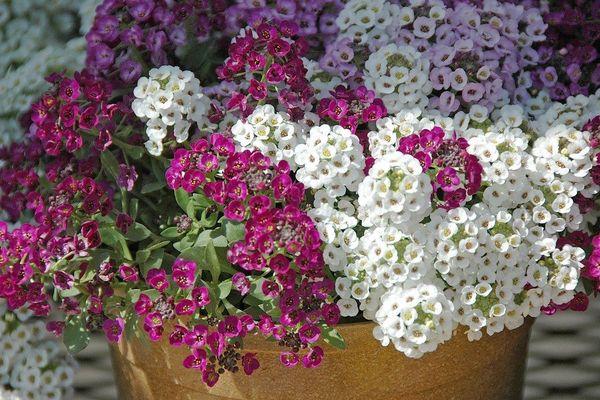

Picking
This manipulation can be performed only after 2 pairs of true leaves have formed on the young plant.
Before diving for young sprouts, it is necessary to apply top dressing, approximately 3-4 days in advance. And the day before, water the soil abundantly. It is the creation of these conditions that will allow you to avoid stress.
Topping
Most often, pinching is carried out when Alicium does not have enough light, and it begins to stretch up intensively.
Protection against diseases and pests
For inexperienced amateur gardeners, it is worth considering that alyssum belongs to the cruciferous group. That is, its closest relatives are a wide variety of cabbage varieties. That is why this plant is attacked by caterpillars, cabbage butterflies or white beetles, flea beetles.
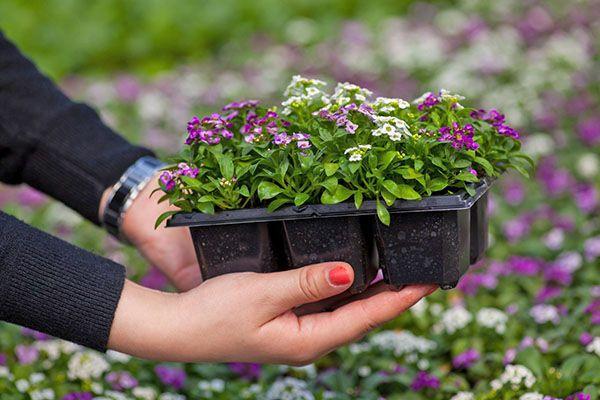

Caterpillars
To exterminate these parasites, drugs such as Actellik or Fitoverm are used. By the way, they are effective against other pests.
Cruciferous fleas
It is enough to process the planting with a tincture of garlic, as there will be no traces of the cruciferous flea.
You can use traditional garlic concentrate, which is prepared as follows:
- chop the heads of garlic, along with the husk and fill the selected container about half;
- the rest of the volume is added with water;
- defend for 10 days in the dark;
- then filtered;
- take 2 tablespoons of the concentrate and dilute them in 10 liters of water;
- plants that need it are treated with this agent.
Please note that the resulting infusion can be stored for six months in a cool place.
White butterflies
Garlic concentrate or Actellik can also be used from this butterfly. You can also pick up other chemicals that are sold in sufficient quantities in specialized stores.
Cabbage moths
In this case, the Aktelik tool will also help to cope with the problem. It should be noted that it effectively manifests itself when getting rid of any types of insects.

